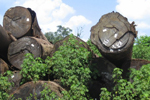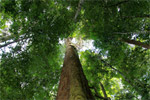Innovation in Tropical Forest Conservation: Q&A with Corey Bradshaw
 Primary peat forest in Sumatra. Photo by Rhett A. Butler.
Primary peat forest in Sumatra. Photo by Rhett A. Butler.
Much of Dr. Corey Bradshaw’s work has a singular aim: to keep primary habitats and functioning ecosystems intact. According to Bradshaw, the existing system of carbon trading rules needs to be changed so that primary forests are given a higher value than other forms of land use.
“Nothing,” Bradshaw told mongabay.com “can replace primary vegetation, both in terms of biodiversity value and other ecosystem services.” He adds that, “while certainly not ‘innovative’ in terms of concepts, there has yet to be designed a globally effective financial incentive to protect existing forests of sufficient magnitude and quality to preserve biodiversity.”
Currently, Bradshaw currently holds the Chair of Ecological Modeling at the University of Adelaide’s Environment Institute. He specializes in using mathematical modeling to find global-scale patterns in threats to biodiversity and uses these models to influence government and private policies worldwide.
Bradshaw also serves as editor of four international scientific journals: Ecology Letters, Frontiers in Ecology and Evolution, Journal of Animal Ecology, F1000Research; has published over 210 peer-reviewed scientific articles, 9 book chapters and a book (with another nearing publication); and has won many awards including the 2010 Australian Ecology Research Award, and the 2010 Scopus Young Researcher of the Year.
His blog, ConservationBytes.com, discusses and critiques the science of conservation and has over 1,000 visits daily from readers around the world.

Corey Bradshaw.
An Interview with Corey Bradshaw
Mongabay.com: What is your background?
Corey Bradshaw: I have a rather eclectic background in conservation ecology. I grew up in the wilds of western Canada, the son of a trapper. My childhood experiences initially gave me a primarily consumptive view of the environment from trapping, fishing and hunting, but I learned that without intact environmental functions, these precious resources quickly degrade or disappear. This ironic appreciation of natural processes would later lead me into academia and the pursuit of reducing the rate of the extinction crisis.
I completed my first degrees in ecology in Montréal and the University of Alberta, followed by a PhD in New Zealand at the University of Otago. After deciding to pursue the rest of my career in the Southern Hemisphere, I completed my postdoctoral fellowship at the University of Tasmania. Multiple field seasons in the subantarctic and Antarctica probably assisted in a giving me a burgeoning desire to change gears, so I left for the tropics of northern Australia to begin a position at Charles Darwin University. Being introduced there to conservation greats like Navjot Sodhi (sadly, now deceased), Barry Brook and David Bowman turned my research interests on their ear. I quickly became enamored with quantitative conservation ecology, applying my skills in mathematics to the plight of the world’s ecosystems. Nowhere did the problems seem more intractable than in the tropics.
I am now based at the University of Adelaide (since 2008) and have a vibrant research lab where we apply our quantitative skills to everything from conservation ecology, climate change, energy provision, human population trends, ecosystem services, sustainable agriculture, human health, paleoecology, carbon-based conservation initiatives and restoration techniques.

Corey Bradshaw.
Mongabay.com: How long have you worked in tropical forest conservation and in what geographies? What is the focus of your work?
Corey Bradshaw: I tend to take a broad-scale approach to my work, so the tropics in particular represent just one part of my focus. My team and I use large species datasets to test hypotheses about general ecological trends and processes. My interest in tropical forests in particular is based on their superior biodiversity value, high threat and, perhaps ironically, their sensitivity to climate change. My real interest in the tropics began when I first moved to northern Australia in 2004. Spending time there and in Singapore working with Navjot Sodhi, I became interested in the desperate plight of tropical biotas after seeing first hand how quickly they were disappearing.
Mongabay.com: What do you see at the next big idea or emerging innovation in tropical forest conservation? And why?
Corey Bradshaw: It has become clear to me that nothing can replace primary vegetation, both in terms of biodiversity value and other ecosystem services (e.g., flood mitigation and carbon storage). While restoration is essential given the extent and rate of primary forest loss, we need financial mechanisms to guard what’s left. While certainly not ‘innovative’ in terms of concepts, there has yet to be designed a globally effective financial incentive to protect existing forests of sufficient magnitude and quality to preserve biodiversity. From my own work and that of colleagues, even protected areas are under siege and can by no means ensure biodiversity maintenance. I therefore see the most promising innovation in tweaking existing carbon-trading rules to value primary forest above all other forms of land use, effectively erasing the unfortunate requirement of ‘additionality’ (providing more carbon benefits than would have happened anyway without investment) for any carbon market-financed incentives. This would need to be done at the global level (e.g., Kyoto 2) as well as incorporated into the national markets of emerging and established economies, both in the tropics and elsewhere.
Mongabay.com: What are the primary obstacles to “tweaking existing carbon-trading rules to value primary forest”?
Corey Bradshaw: The ‘additionality’ requirement. [Also] ensuring that no ‘leakage’ occurs, and that the forests are maintained in permanence – these three [leakage, permanence and additionality] make up the unholy trinity of carbon-financed forest protection. See associated blog post Unholy trinity of leakage, permanence and additionality.
The Amazon rainforest. Photo by Rhett A. Butler.
Mongabay.com: Are you personally involved in any projects or research that represent emerging innovation in tropical forest conservation?
Corey Bradshaw: I mentioned that we’ve established some pretty convincing evidence that nothing can replace primary forests, and I have done some preliminary work on improving the financial incentives for protecting them. I have also been involved in setting up some of the world’s first biodiversity-carbon restoration experiments, both in the tropics and temperate zones of Australia. I hope to be able to expand these projects to provide sound restoration advice to other regions, but of course, money is always the limiting component.

Peatland going up in flames for palm oil production in Riau, Indonesia in February 2014. Photo by Rhett A. Butler.
Related articles
Zero net deforestation is the wrong target, warn experts

(11/14/2013) Environmental initiatives that target zero net deforestation may miss their mark when it comes to slowing climate change and protecting biodiversity, warns a commentary published in this week’s issue of the journal Science. While zero net deforestation may seem like a worthy target in efforts to curb forest loss, Sandra Brown and Daniel Zarin argue that the goal is at best, ambiguous, and at worst, may lead to perverse outcomes for the world’s forests.
Old-growth trees store half rainforest carbon

(08/07/2013) Large trees store store up to half the above-ground biomass in tropical forests, reiterating their importance in buffering against climate change, finds a study published in Global Ecology and Biogeography. The research, which involved dozens of scientists from more than 40 institutions, is based on data from nearly 200,000 individual trees across 120 lowland rainforest sites in Africa, Asia, and Latin America. It found that carbon storage by big trees varies across tropical forest regions, but is substantial in all forests.
Global decline of big trees in old-growth forests worrying, argue scientists
(12/06/2012) The decline of large trees is putting biodiversity and forest health at risk globally, warn researchers writing in the journal Science.
Experts: sustainable logging in rainforests impossible

(07/19/2012) Industrial logging in primary tropical forests that is both sustainable and profitable is impossible, argues a new study in Bioscience, which finds that the ecology of tropical hardwoods makes logging with truly sustainable practices not only impractical, but completely unprofitable. Given this, the researchers recommend industrial logging subsidies be dropped from the UN’s Reducing Emissions from Deforestation and Forest Degradation (REDD+) program. The study, which adds to the growing debate about the role of logging in tropical forests, counters recent research making the case that well-managed logging in old-growth rainforests could provide a “middle way” between conservation and outright conversion of forests to monocultures or pasture.
Industrial logging leaves a poor legacy in Borneo’s rainforests

(07/17/2012) For most people “Borneo” conjures up an image of a wild and distant land of rainforests, exotic beasts, and nomadic tribes. But that place increasingly exists only in one’s imagination, for the forests of world’s third largest island have been rapidly and relentlessly logged, burned, and bulldozed in recent decades, leaving only a sliver of its once magnificent forests intact. Flying over Sabah, a Malaysian state that covers about 10 percent of Borneo, the damage is clear. Oil palm plantations have metastasized across the landscape. Where forest remains, it is usually degraded. Rivers flow brown with mud.
Greenpeace calls for global REDD standards to reduce negative impacts of forest carbon projects
(06/26/2012) Greenpeace has launched a consultation process to establish global standards for Reducing Emissions from Deforestation and Degradation (REDD+) projects.
Logging of primary rainforests not ecologically sustainable, argue scientists

(01/25/2012) Tropical countries may face a risk of ‘peak timber’ as continued logging of rainforests exceeds the capacity of forests to regenerate timber stocks and substantially increases the risk of outright clearing for agricultural and industrial plantations, argues a trio of scientists writing in the journal Biological Conservation. The implications for climate, biodiversity, and local economies are substantial.
Loss of old growth forest continues

(10/06/2010) A new global assessment of forest stocks by the U.N. Food and Agriculture Organization (FAO) shows continuing loss of primary forests since 2005 despite gains in the extent of protected areas. FAO’s Global Forest Resources Assessment 2010 reveals some 13 million hectares of forest were cleared between 2000 and 2010, down from around 16 million hectares per year during the 1990s. Loss of primary forest—mostly a consequence of logging—averaged 4.2 million hectares per year, down from 4.7 million hectares per year in the 1990s.
REDD may increase the cost of conservation of non-forest ecosystems
(11/19/2009) Policy-makers designing a climate change mitigation mechanism that will reduce emissions from deforestation and degradation (REDD) aren’t doing enough to ensure that the scheme protects biodiversity outside carbon-dense ecosystems, argues an editorial published in Current Biology by a group of scientists.

(06/09/2009) A global framework on climate change must immediately halt deforestation and industrial logging of the world’s old-growth forests, while protecting the rights of forest communities and indigenous groups, said a broad coalition of activist groups in a consensus statement issued today at U.N. climate talks in Bonn Germany. The statement said the successor treaty to the Kyoto Protocol should not include mechanisms that allow industrialized countries to “offset” their emissions by purchasing carbon credits from reducing deforestation in developing countries, a position that puts the coalition at odds with larger environmental groups who say a market-based approach with tradable credits is the only way to generate enough money fund forest protection on a global scale.
